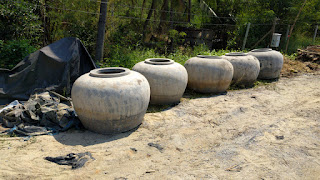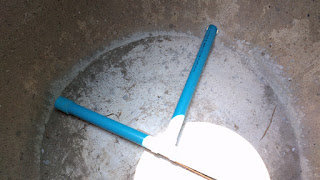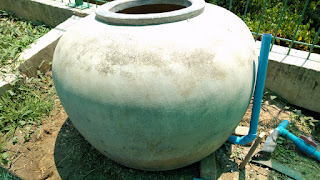Building a slow sand filter has been on my to-do list of projects for quite some time now. Its turn has finally come.
We had previously purchased some large second hand urns from our neighbors for building a few slow sand filters:
My current design starts with placing some PVC pipe in the bottom of an urn like this:
This pipe has small holes drilled in the bottom (45 degrees on both sides of straight down) so that water can enter the pipe and flow out of the filter. The holes are on the bottom side so that any sand or small rocks that fall through the layers won’t clog up the holes. (This is the same as the larger 12″ PVC pipes in our giant pond sand filtration area.)
We will then put down a 10cm layer of washed gravel to cover the pipe, followed by a 10cm layer of small pebbles, followed by a 10cm layer of coarse washed sand, followed by a 20cm layer of fine washed sand, followed by a 15cm layer of rice husk ash. Interestingly, rice husk ash seems to have some advantages over the fine sand according to this link and some of the research into this has come out of Thailand. Rice husk ash is really easy to source here, much easier than uniform fine sand.
The concept behind this stack is that the gravel at the bottom is large enough that it won’t easily clog up the holes in the pipe, and the fine sand and rice husk ash at the top are small enough for effective water filtration. Then, each intermediate layer is made of particles large enough that it won’t slip down through the layer below, and small enough that the layer above can’t slip down through it. The fine sand and the rice husk ash provide a medium which will hopefully grow the biological layer (schmutzdecke) that is the primary mechanism of purification.
The coarse washed sand is the sand we washed for the pond, and we noticed that when we were washing the sand, some of the run-off was fine uniform sand exactly the size that was recommended for slow sand filtration (about 0.2mm) and very uniform. Size and uniformity are said to be important to how well the schmutzdecke can grow in the sand. Since we washed several hundred cubic meters of sand, we ended up with several cubic meters of this fine stuff which we saved for this.
The pipe then routes the water out of the bottom of the urn through a hole, which we will seal with cement and then silicon sealant. On the outside of the urn, the PVC pipe turns upwards:
The upwards turn looks a bit like a snorkel and will be attached to an outlet pipe that will drop into a cistern for storage of the filtered water. This snorkel like extension is important to make sure the surface of the filter never dries out. The schmutzdecke will die out if it ever dries up, resulting in little or no filtration after that, so this needs to be avoided. Since water will only flow out of the sand filter if the level of the water in the urn is higher than the level of the outlet “snorkel”, setting the level of the outlet pipe determines the lowest level of the water in the urn. After we fill up the urn with the filtration media, we will cut the pipe to the right level (using the water level in the pipe as a guide) and then mount the outlet coupling.
One little tip I read about was that the gravel and sand should be filled in after filling the urn with water. Apparently, air bubbles caught inside the sand can have a significant negative impact on the output water quality, and gravel and sand loaded in while dry will likely hold air bubbles when the water is added later. But if the water is added first, then there will be no air down there to form bubbles right from the very beginning.
The target purpose of this first slow sand filter prototype is for filtering grey water like roof runoff to prepare it for watering edible plants. Roof runoff may have trace amounts of lizard or bird droppings which results in a risk of E. coli contamination on vegetables that will be eaten fresh. Most of the studies listed on this page show that an intermittently operated slow sand filter (such as a home system like ours where water won’t be passing through it non-stop 24 hours per day) have E. coli reduction rates in the 92%-97% range. The American government’s Centers for Disease Control page on slow sand filters shows an E. coli removal rate of 80%-98%. (The lower end of this might be for sand filters that weren’t operated correctly, so I am hoping we will be able to achieve closer to the higher end of this range.) In any event, these slow sand filters appear to be very effective at removing pathogens from dirty water. And the roof runoff is probably not that dirty to begin with.
If we can show that the first slow sand filter is working well, I may later consider a more ambitious use of a slow sand filter as a pre-filtration stage for turning pond water into drinking water for the floating house. (In my current idea, the slow sand filter would still be followed by a commercial water filter specifically designed to make pond water potable. We found one of these at a store on Sukhumvit Road that sells only branded commercial water filters. No point in taking risks with something as critical to health as home drinking water.)
But that is really getting ahead of myself. Step one is to get this first slow sand filter working for a few months and then to send the input and output water to a professional water quality testing lab to see what the pathogen removal levels are like.
Hopefully the output water won’t be worse than the input water!
(⊙▃⊙)


